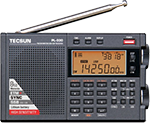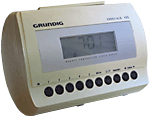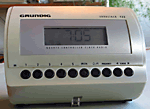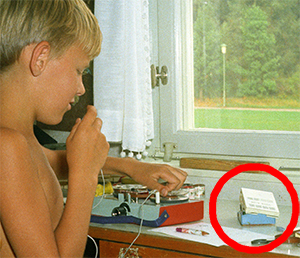Technical data
- Frequency range: 153-513 kHz AM | 522-1620 kHz AM | 1711–29999 kHz AM/SSB | 87–108 MHz FM
- Station memory: 850 with auto sorting function
- Synchronous detection
- Sensitivity: Not published
- Audio out: 3,5 mm earphone 32 ohm
- Antenna: 50 ohm, BNC female
- Power supply: 5 V DC ≥ 500 mA USB
- Battery: 3.7V BL-5C Li-ion batteri
- Dimensions: 139×85×26 mm
- Weight: 210 g
Documents
2023 January
Hans has already a modern shortwave transceiver but wants a small receiver as a complement.
The Tecsun receiver is small and has SSB reception. The receiver is bought 2022-12-17 from Limmared Radio for 1150 SEK and is picked-up from AMS Supermarket 2022-01-18 as a DHL package.
Good
- Small and easy to use.
- Has SSB mode.
Bad
- Muted during frequency change.
- As usual, requires an external antenna to be useful on shortwave.
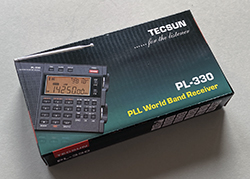
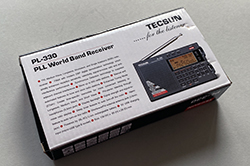

Technical data
- Frequency range: 78–87.3 MHz NFM | 87.3–108 MHz WFM | 108–137 MHz AM | 137–174 MHz NFM | 406–512 MHz NFM
- Channels: 180 in 9 banks
- Scan speed: 30 steps/s
- Sensitivity, 12 dB SINAD: 0.3/0.4/0.9 µV
- Audio out: 3,5 mm earphone
- Antenna: 50 ohm, BNC female
- Power supply: 4.5 V, 3 × AA batteries
- Dimensions: 104×53×28 mm
- Weight: 100 g
Documents
2018 August
Hans flew to Finland in the beginning of August and brought his old pen-size airband receiver. It did not work at all. So before his next flight he decides to get a new airband radio, preferable a scanner.
Instead of going for an all band receiver like Icom R6 he decides to buy a dedicated air band scanner. The EZI33XLT is bought 2018-08-21 from Limmared Radio for 795 SEK.
Serial No: 78000093
Good
- Small.
- Few buttons but easy to use.
Bad
- Perhaps not the fastest scanner.
- No dial for frequency enter, only up/down-buttons.
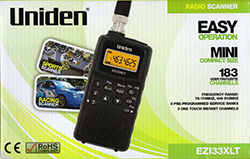
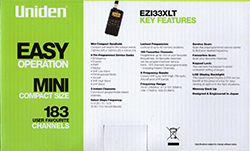
Diamond RH795 antenna, August 2018

The included rubber duck antenna is good for operation on the go. But for better reception this extendable 1/4 wave, telescopic whip antenna is superior. The antenna is bought 2018-08-21 from Limmared Radio for 295 SEK.
- Range: 70–1000 MHz
- Gain: 2,15 dBi
- Length: 19,5–113 cm, 10 stages
- Weight: 65 g
Image courtesy: Limmared radio
The instruction specifies an antenna length of 56 cm for 120 MHz. This is equal to 3 sections and an additional 3 cm.
Technical data
- Frequency range: 58-176 MHz divided in 3 bands: CB, TV1+FM and AIR+WB+PB
- Sensitivity, 12 dB SINAD: Missing
- Audio out: 3,5 mm earphone
- Antenna: Telescopic 16-50 cm
- Power supply: 6 V, 4×AA batteries or external 6 V
- Dimensions: 200×90×50 mm
- Weight without batteries: 375 g
Documents
- Missing
20xx
Hans' small air band receiver is not working. He buys a cheap multi-band receiver instead.
Good
- Cheap.
- Can be powered by batteries or AC adapter.
Bad
- Quite large.
- Low selectivity.
2020-01-02 End of life
The receiver has been unused for many years. When Hans inserts batteries and switch it on, he realizes that it is of no use. The volume and squelch potentiometers are faulty and there seem to be no selectivity. Many channels are heard simultaneously.
Hans leave the receiver for recycling.
Technical data
- Function: Clock radio with battery backup
- FM and AM, digital tuning
- Time setting with summer time button
- Voltage supply from 230 V AC
- Battery backup: 3×AAA
- Dimensions: 170×135×110 mm
- Weight: 0.7 kg
Documents
- None
August 1995
Hans gets a small flat in Stockholm for sleeping over. He needs a nice clock radio and finds this one in an old fashion radio store at Hornsgatan.
Good
- Very good sound, nice design
- Battery backup
Bad
- Not clear how to set time
- ???
End of life 2020
In January 2020 the unit is picked up from the storage room in the basement. The radio receiver has not been used for 20 years. Since 2002 Hans uses his mobile phone as a wake up clock. Therefore the receiver is left for recycling 2020-01-07.
Technical data
- Frequency range: 110–140 MHz
- Audio out: 2,5 mm earphone
- Antenna: 10 cm pin attached
- Power supply: 3 V, 2×386 batteries (⌀11.6×4.2 mm)
- Dimensions: ⌀15×120 mm
- Weight: 33 g
1995
Hans starts travelling by airplane quite frequently and wants an air band receiver. World Import in Stockholm has exactly what he wants; a small receiver that can be kept in the shirt pocket.
The receiver has no loudspeaker and no volume control.
Good
- Small.
- Easy to use.
Bad
- Small frequency dial.
- No volume control.
The catalog is from 1976.
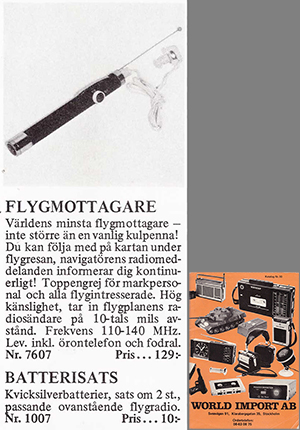
End of life August 2018
After trying to use the receiver on a flight in August, Hans discover that no signals can be received. It is left for recycling
Technical data
- Function: Kitchen radio with battery backup
- FM 88–108 MHz and AM 540–1600 kHz, analog tuning
- Voltage supply from 230 V AC
- Battery backup: 9 V
- Dimensions: 200×155×75 mm
- Weight: 0.8 kg
Documents
- None
July 1991
Hans gets a new flat in Rönnby and needs a kitchen radio. This one has a mounting frame that is attached underneath the kitchen storage boxes.
Good
- Easy to switch preprogrammed radio-channels set by dials on the back.
- Easy to read clock
Bad
- Not accurate clock
- ???
End of life 2020
In January 2020 the unit is picked up from the storage room. It has not been used since Hans moved from his appartment in Rönnby 1994. The unit is left for recycling 2020-01-07.

Technical data
- Functions: Clock radio
- Receiver type: Super-hetrodyne
- Receiver: FM xx–xx MHz, AM xxx–xxxx kHz
- Power output: 0.2 W
- Interfaces: None
- Batteries: 4×1.5 V AA
- Dimensions: 172×110×40 mm
- Weight: 0.2 kg
Documents
- None
January 1974
Hans has earned some money during his summer job and decided to get the latest invention: A portable clock radio with LCD display. So far all clock radios were mains connected using LED displays.
This is probably one of the first radios with an LCD clock.
Good
- xxx
- xxxx
Bad
- ???
- ???

Technical data
- Receiver type: Super-hetrodyne
- Frequency: AM 535–1605 kHz
- Power output: Unknown
- Interfaces: Earphone socket 3,5 mm
- Batteries: 1×9 V PP3
- Dimensions: 57×95×25 mm
- Weight: Unknown
Documents
- None
December 1966 ?
At Christmas Hans gets a typical Japanese transistor radio in pocket format with extendable antenna. It is light blue and has only two controls; a combined volume control on/off swich, a tuning knob ? (and on the back side; an AM/FM selector switch.)?
Good
- Hans' first radio, and a very cool one because it is small. His friends are impressed.
- Hans can listen to Radio Luxembourg.
Bad
- Limited sound quality
- –
